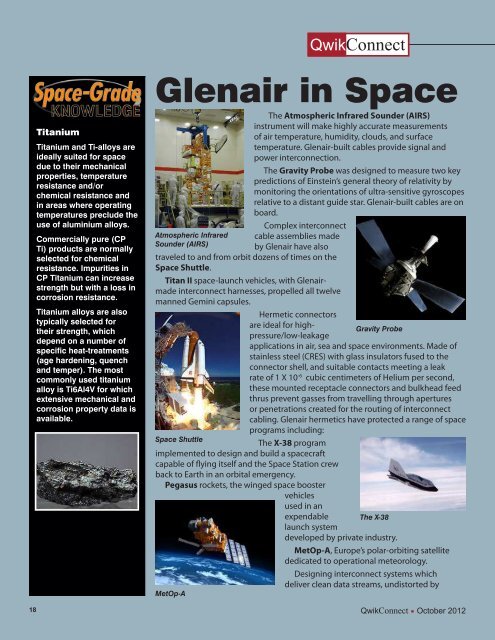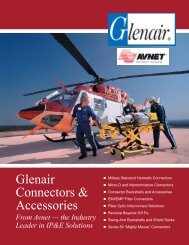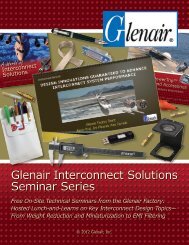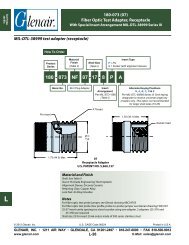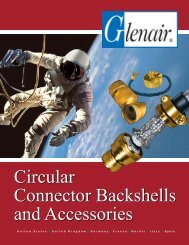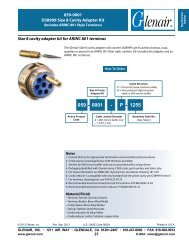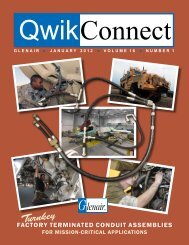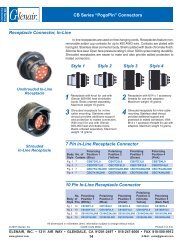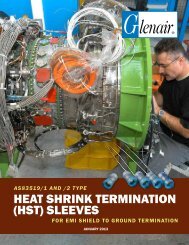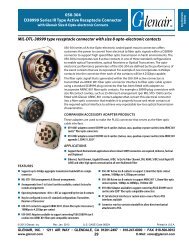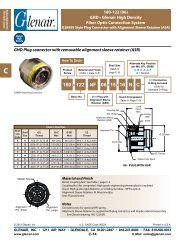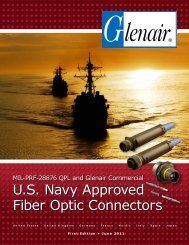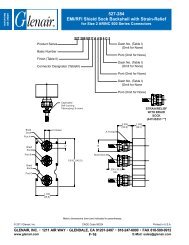Two page spread - Glenair, Inc.
Two page spread - Glenair, Inc.
Two page spread - Glenair, Inc.
You also want an ePaper? Increase the reach of your titles
YUMPU automatically turns print PDFs into web optimized ePapers that Google loves.
QwikConnect<br />
Titanium<br />
Titanium and Ti-alloys are<br />
ideally suited for space<br />
due to their mechanical<br />
properties, temperature<br />
resistance and/or<br />
chemical resistance and<br />
in areas where operating<br />
temperatures preclude the<br />
use of aluminium alloys.<br />
Commercially pure (CP<br />
Ti) products are normally<br />
selected for chemical<br />
resistance. Impurities in<br />
CP Titanium can increase<br />
strength but with a loss in<br />
corrosion resistance.<br />
Titanium alloys are also<br />
typically selected for<br />
their strength, which<br />
depend on a number of<br />
specific heat-treatments<br />
(age hardening, quench<br />
and temper). The most<br />
commonly used titanium<br />
alloy is Ti6Al4V for which<br />
extensive mechanical and<br />
corrosion property data is<br />
available.<br />
<strong>Glenair</strong> in Space<br />
Atmospheric Infrared<br />
Sounder (AIRS)<br />
The Atmospheric Infrared Sounder (AIRS)<br />
instrument will make highly accurate measurements<br />
of air temperature, humidity, clouds, and surface<br />
temperature. <strong>Glenair</strong>-built cables provide signal and<br />
power interconnection.<br />
The Gravity Probe was designed to measure two key<br />
predictions of Einstein’s general theory of relativity by<br />
monitoring the orientations of ultra-sensitive gyroscopes<br />
relative to a distant guide star. <strong>Glenair</strong>-built cables are on<br />
board.<br />
Complex interconnect<br />
cable assemblies made<br />
by <strong>Glenair</strong> have also<br />
traveled to and from orbit dozens of times on the<br />
Space Shuttle.<br />
Titan II space-launch vehicles, with <strong>Glenair</strong>made<br />
interconnect harnesses, propelled all twelve<br />
manned Gemini capsules.<br />
Hermetic connectors<br />
are ideal for highpressure/low-leakage<br />
Gravity Probe<br />
applications in air, sea and space environments. Made of<br />
stainless steel (CRES) with glass insulators fused to the<br />
connector shell, and suitable contacts meeting a leak<br />
rate of 1 X 10 -6 cubic centimeters of Helium per second,<br />
these mounted receptacle connectors and bulkhead feed<br />
thrus prevent gasses from travelling through apertures<br />
or penetrations created for the routing of interconnect<br />
cabling. <strong>Glenair</strong> hermetics have protected a range of space<br />
programs including:<br />
Space Shuttle<br />
The X-38 program<br />
implemented to design and build a spacecraft<br />
capable of flying itself and the Space Station crew<br />
back to Earth in an orbital emergency.<br />
Pegasus rockets, the winged space booster<br />
vehicles<br />
used in an<br />
expendable The X-38<br />
launch system<br />
developed by private industry.<br />
MetOp-A, Europe’s polar-orbiting satellite<br />
dedicated to operational meteorology.<br />
Designing interconnect systems which<br />
deliver clean data streams, undistorted by<br />
MetOp-A<br />
electromagnetic interference or pulses (EMI/EMP) is a significant challenge. A<br />
well designed interconnect system will include a complement of grounding and<br />
shielding technologies to insure EMC. EMI filter connectors, packaged in just<br />
about any connector style or interface size, are<br />
an effective method to achieve electro-magnetic<br />
compatibility. The filter device strips off unwanted<br />
signals which have grounded to conductive wires<br />
and enclosure surfaces before the signal can affect<br />
system performance.<br />
<strong>Glenair</strong> is extremely well versed in supplying<br />
filter connector products optimized for use in<br />
Skynet<br />
space-grade applications, providing products<br />
compliant to EEE-INST-002, Table 2G, the recognized standard for space grade filters.<br />
<strong>Glenair</strong> Filtered connector space applications include:<br />
Skynet, for the United Kingdom Ministry of Defence, to provide strategic<br />
communication services to the three branches of the<br />
British Armed Forces and to NATO forces engaged on<br />
coalition tasks.<br />
The Lincoln Near Earth Asteroid Research<br />
(LINEAR), an MIT Lincoln Laboratory program funded<br />
by the US Air Force and NASA. LINEAR is dedicated to<br />
the problem of detecting and cataloging near-Earth<br />
asteroids that threaten the Earth.<br />
JWST<br />
The James Webb Space<br />
Telescope (JWST) is a large, infrared-optimized space<br />
telescope, scheduled for launch in 2014. JWST will find<br />
the first galaxies that formed in the early Universe,<br />
connecting the Big Bang to our own Milky Way Galaxy.<br />
Herschel Space<br />
Observatory<br />
Micro-D connectors, including standard potted<br />
products, hermetics, filters, and flex assemblies are<br />
commonly used in space applications due to their highperformance<br />
and small size. The precision machined<br />
shell of the Micro-D, with its robust mating retention<br />
forces makes for an ideal connector for missile, rocket<br />
and space-vehicle applications that are subject to high<br />
levels of vibration and shock. The Micro-D is easily<br />
customized with package and mounting modification to fit virtually any integration<br />
challenge. Here is a selection of current and past space applications that use these<br />
miniaturized <strong>Glenair</strong> Micro-D connectors:<br />
The Herschel Space Observatory, from the European<br />
Space Agency, will determine facts about Galaxy formation,<br />
Star formation, and the Chemical composition of<br />
atmospheres and surfaces of planets, comets and moons.<br />
The European Space Agency is also developing and<br />
building the Gaia satellite due to be launched in 2013. Its<br />
mission is to construct the largest and most precise map to<br />
date of the Milky Way.<br />
Gaia satellite<br />
Copper<br />
Copper and copper-based<br />
alloys are established<br />
materials in electrical,<br />
electronic and also in<br />
more general engineering<br />
applications. The main<br />
applications for copper in<br />
space include electrical/<br />
electronic subsystems<br />
(wiring, terminals in<br />
soldered assemblies)<br />
and plating (electronics,<br />
thermal control, corrosion<br />
protection and so on).<br />
Electronic assemblies use<br />
wires made of high-purity<br />
copper or copper alloy<br />
and terminals of copper<br />
alloy.<br />
Beryllium-copper (also<br />
known as copperberyllium)<br />
is an alloy<br />
with small additions of<br />
Beryllium commonly used<br />
for spring members and<br />
retention clips particularly<br />
in high-strength, corrosion<br />
resistant components and<br />
in safety applications in<br />
hazardous environments<br />
(no sparks are produced<br />
when impacted).<br />
18 QwikConnect • October 2012<br />
QwikConnect • October 2012 19


